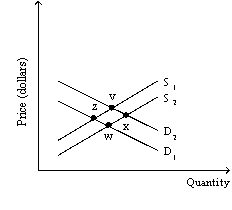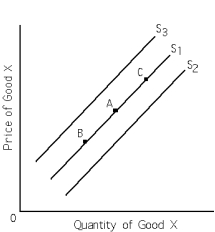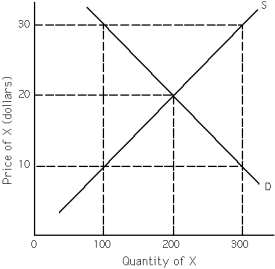A) greater than;greater than
B) less than;greater than
C) greater than;less than
D) less than;less than
Correct Answer

verified
Correct Answer
verified
Multiple Choice
Exhibit 3-3  Good Y
-Refer to Exhibit 3-3.A shift in demand from D1 to D2 can NOT occur from a change in the
Good Y
-Refer to Exhibit 3-3.A shift in demand from D1 to D2 can NOT occur from a change in the
A) population.
B) price of a substitute for good Y.
C) average income of good Y buyers.
D) price of good Y.
Correct Answer

verified
Correct Answer
verified
Multiple Choice
Resource X is necessary to the production of good Y.If the price of resource X falls,the equilibrium price of Y will ______________ and the equilibrium quantity of Y will
A) rise;rise.
B) fall;fall.
C) fall;rise.
D) rise;fall.
Correct Answer

verified
Correct Answer
verified
Multiple Choice
Exhibit 3-5  -Refer to Exhibit 3-5.In the market shown,if equilibrium was originally at point W and is now at point X,the new equilibrium price is __________ it was originally and the new equilibrium quantity is ____________ it was originally.
-Refer to Exhibit 3-5.In the market shown,if equilibrium was originally at point W and is now at point X,the new equilibrium price is __________ it was originally and the new equilibrium quantity is ____________ it was originally.
A) greater than;greater than
B) less than;greater than
C) greater than;less than
D) less than;less than
Correct Answer

verified
Correct Answer
verified
Multiple Choice
Oil producers expect that oil prices next year will be lower than oil prices this year.As a result,oil producers are most likely to
A) place more oil on the market this year,thus shifting the present supply curve of oil rightward.
B) hold some oil off the market this year,thus shifting the present supply curve of oil leftward.
C) place more oil on the market this year,thus increasing the quantity supplied of oil at lower but not higher prices.
D) hold some oil off the market this year,thus decreasing the quantity supplied of oil at lower but not higher prices.
Correct Answer

verified
Correct Answer
verified
Multiple Choice
Exhibit 3-7  -Refer to Exhibit 3-7.If S1 is the relevant supply curve,an increase in the price of good X may cause
-Refer to Exhibit 3-7.If S1 is the relevant supply curve,an increase in the price of good X may cause
A) the supply of good X to shift from S1 to S2
B) the supply of good X to shift from S1 to S3.
C) a movement along S1 perhaps from point A to point B.
D) a movement along S1 perhaps from point A to point C.
E) no change in the quantity supplied of good X.
Correct Answer

verified
Correct Answer
verified
True/False
When a market is in disequilibrium,such as when the quantity supplied of a good is greater than the quantity demanded of that good,the price of the good will rise,ceteris paribus.
Correct Answer

verified
Correct Answer
verified
Multiple Choice
Which of the following is descriptive of the law of diminishing marginal utility?
A) The third hamburger consumed provides less utility than the second hamburger consumed.
B) The third hamburger is priced higher than the first hamburger.
C) As price falls,quantity demanded rises,ceteris paribus.
D) The price of a good rises as the costs of producing that good rise.
E) none of the above
Correct Answer

verified
Correct Answer
verified
Multiple Choice
If a supply curve shifts rightward,this means
A) suppliers are willing and able to offer less of the good for sale at every price.
B) suppliers are willing and able to offer more of the good for sale at every price.
C) quantity supplied is greater at every price.
D) suppliers are willing and able to offer more of the good for sale only at a particular price.
E) b and c
Correct Answer

verified
Correct Answer
verified
Multiple Choice
Exhibit 3-14
 -Refer to Exhibit 3-14.At a price of $15,there is a ____________ unit ____________ of good X.
-Refer to Exhibit 3-14.At a price of $15,there is a ____________ unit ____________ of good X.
A) 40;shortage
B) 90;surplus
C) 40;surplus
D) 20;shortage
E) 20;surplus
Correct Answer

verified
Correct Answer
verified
Multiple Choice
At a price above the equilibrium price,there is
A) a shortage.
B) a surplus.
C) excess demand.
D) super-equilibrium.
E) none of the above
Correct Answer

verified
Correct Answer
verified
Multiple Choice
Exhibit 3-10  -Refer to Exhibit 3-10.300 units of X will be exchanged in this market if the price is
-Refer to Exhibit 3-10.300 units of X will be exchanged in this market if the price is
A) $30.
B) $20.
C) $10.
D) any of the above
E) none of the above
Correct Answer

verified
Correct Answer
verified
Multiple Choice
Which of the following statements best represents the law of supply?
A) Price and quantity supplied are inversely related.
B) Price and quantity supplied are directly related.
C) Price and quantity supplied are inversely related,ceteris paribus.
D) Price and quantity supplied are directly related,ceteris paribus.
E) Price and supply are directly related,ceteris paribus.
Correct Answer

verified
Correct Answer
verified
Multiple Choice
Resource X is necessary to the production of good Y.If the price of resource X rises,
A) the supply curve of Y shifts leftward.
B) the supply curve of Y shifts rightward.
C) the supply curve of Y is unaffected.
D) there is a movement down the supply curve of Y.
E) there is a movement up the supply curve of Y.
Correct Answer

verified
Correct Answer
verified
Multiple Choice
A market is said to be in disequilibrium if
A) it exhibits either a surplus or a shortage.
B) the number of units that individuals are willing to buy exceeds the number of units they can afford.
C) it is a market for an inferior good.
D) none of the above
Correct Answer

verified
Correct Answer
verified
Multiple Choice
Which of the following illustrates the law of demand?
A) Jorge buys fewer pencils at $2 per pencil than at $1 per pencil,ceteris paribus.
B) Chen buys more ice cream at $4 per half-gallon than at $3 per half gallon,ceteris paribus.
C) Karissa buys fewer sweaters at $50 each than at $35 each,ceteris paribus.
D) a,b,and c
E) a and c
Correct Answer

verified
Correct Answer
verified
Multiple Choice
If demand increases by a lesser amount than supply increases,then equilibrium price __________ and equilibrium quantity __________.
A) rises;falls
B) falls;falls
C) rises;rises
D) falls;rises
Correct Answer

verified
Correct Answer
verified
Multiple Choice
At a price below the equilibrium price,there is
A) a surplus.
B) a shortage.
C) excess supply.
D) sub-equilibrium.
E) none of the above
Correct Answer

verified
Correct Answer
verified
Multiple Choice
At a price for which the quantity supplied exceeds the quantity demanded,a __________ is experienced,which pushes the price __________ toward its equilibrium value.
A) surplus;downward
B) surplus;upward
C) shortage;downward
D) shortage;upward
Correct Answer

verified
Correct Answer
verified
Multiple Choice
Labor is a resource that is necessary to produce many goods."If the price of labor falls," says the economist,"the prices of goods will soon follow." How does this work?
A) If the price of labor falls,the supply of goods rises,and the prices of those goods fall.
B) If the price of labor falls,the quantity supplied of goods rises,and the prices of those goods fall.
C) If the price of labor falls,the demand for goods falls,and the prices of those goods fall.
D) If the price of labor falls,the demand for goods rises,and the prices of those goods fall.
E) If the price of labor falls,the supply of goods falls,and the prices of those goods fall.
Correct Answer

verified
Correct Answer
verified
Showing 181 - 200 of 227
Related Exams